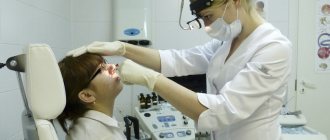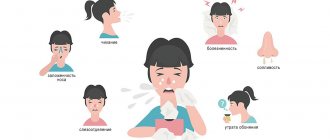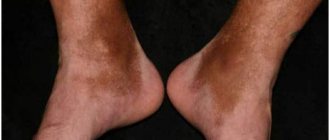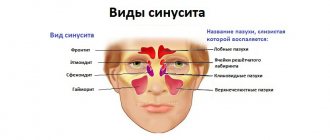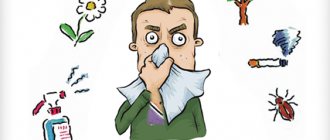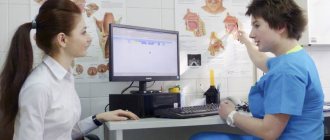Vasomotor rhinitis belongs to the category of chronic diseases of the nasal cavity. This is a chronic runny nose of a non-infectious nature. This diagnosis cannot be called dangerous. But the disease can overcome a person for years, which greatly worsens the patient’s quality of life.
The disease is characterized by inflammation of the nasal mucosa caused by disruption of the blood vessels. The nasal mucosa is penetrated by a huge number of capillaries. In a healthy body, capillaries independently expand and contract under the influence of various stimuli. With vasomotor rhinitis, capillaries begin to respond inadequately to external factors - they expand, but do not return to their original state. As a result, the inferior turbinates become enlarged, nasal congestion appears, and active mucus begins to flow.
Vasomotor rhinitis comes in two varieties:
- vasomotor allergic rhinitis, which occurs as a response of the mucous membrane to interaction with an allergen;
- vasomotor rhinitis of the neurovegetative form, caused by dysregulation of capillaries.
The disease is usually diagnosed in people over twenty years of age. Children and adolescents develop this condition infrequently.
Stages of chronic vasomotor rhinitis
The severity of symptoms of chronic vasomotor rhinitis depends on the stage at which the disease is located.
At the first stage, exacerbations of the disease occur from time to time. Nasal congestion and other unpleasant symptoms appear after contact with an external irritant, such as smoke or cold air.
In the second stage, exacerbations occur more frequently and symptoms become more pronounced. Added to the feeling of stuffiness is itching in the nasal cavity.
At the third stage of the disease, the nasal mucosa begins to change - polyps grow from it. Polyps block the nasal passages and interfere with normal air circulation. Vasoconstrictor drops do not help in this situation.
At the fourth stage, the mucous membrane becomes thicker or, conversely, thins. This leads to a deterioration in the sense of smell and the development of postnasal drip, when mucus drips down the back of the throat. This symptom is especially active in the morning after sleep. The passage of air through the nose noticeably deteriorates.
The sooner the problem is diagnosed, the easier the symptoms will appear. Therefore, do not delay your visit to the otolaryngologist.
Causes
Common causes of the disease are:
- weather changes (cold, temperature changes, changes in humidity levels);
- unfavorable environmental conditions in the place of residence;
- household chemicals with a strong odor;
- use of cosmetics;
- cigarette smoke;
- hormonal changes (pregnancy, menopause, menstruation, endocrine system diseases);
- taking certain medications (hormonal drugs, antidepressants, vasoconstrictors, contraceptives, etc.);
- deviated nasal septum;
- proliferation of adenoids;
- polyps, cysts in the nose;
- consumption of certain foods, including alcohol;
- stress;
- physical overload.
It happens that it is not possible to determine the cause of the capillary regulation disorder. Vasomotor rhinitis of this form is called idiopathic.
Forms and classification
There are quite a few medical classifications of this disease used in a narrow medical environment. The clinical classification is the most convenient and understandable; these are the following forms of rhinitis:
- Atrophic.
- Catarrhal.
- Hypertrophic.
- Vasomotor.
- Professional.
Many doctors consider some of the listed forms of rhinitis to be one form with different, successive stages.
Photo - atrophic rhinitis
Development of vasomotor rhinitis in children
Vasomotor rhinitis in children develops against the background of impaired tone of the blood vessels of the mucous membrane. That is, this type of runny nose is not associated with infection. In case of vasomotor rhinitis, blood vessels begin to dilate due to the child’s contact with the irritant, which leads to swelling of the mucous membrane, followed by a feeling of congestion, discomfort when breathing and other symptoms inherent in a runny nose.
At first it seems like it's a cold or an allergy. But this is a completely different disease. Very often, against the background of swelling of the nasal mucosa with vasomotor rhinitis, a secondary infection occurs. Then the inflammatory process will already be infectious.
The causes of the development of vasomotor rhinitis in children may be:
- long-term and improper treatment with vasoconstrictor drugs;
- stressful situations, nervous overstrain;
- structural features of the nasal cavity (for example, a deviated nasal septum);
- adenoids;
- past infectious diseases (flu, rubella, chickenpox, etc.);
- diseases of the endocrine system;
- nasal injuries;
- external irritants (cold air, smoke, strong odors, spices);
- hormonal changes, for example, during puberty as a teenager.
Moreover, the development of the disease may not be immediately noticeable and develop over several months.
How to determine that a child has developed vasomotor rhinitis? Symptoms of the disease in children are the following phenomena and conditions:
- the child sneezes frequently;
- the nose often “stuffs up”; congestion prevents you from sleeping normally and doing your usual activities;
- there are complaints of a feeling of fullness in the nose;
- mucus appears from the nose; the mucus is clear until an infection sets in, after which it becomes greenish or yellowish;
- due to mucus flowing down the back wall of the throat, the throat often becomes sore;
- the child begins to nasal;
- It becomes difficult to distinguish odors.
To these local signs are added general ones: the child gets tired quickly, becomes lethargic, irritable, and may complain of headaches and dizziness. His appetite decreases.
If these symptoms are detected, it is imperative to show the child to an otolaryngologist.
Preventive measures
To prevent the development of this disease, certain rules should be followed. It is necessary to stop using vasoconstrictor drops and sprays to treat allergic rhinitis. It is advisable not to stay in dusty rooms for a long time and avoid strong odors.
In your daily diet you need to include food containing large amounts of vitamins and microelements. You also need to get rid of bad habits - smoking, alcohol abuse and try not to be in a smoky room.
Any chronic and acute diseases and abnormalities in the functioning of the nasopharynx, gastrointestinal tract, and thyroid gland must be treated in a timely manner.
A person’s lifestyle also plays an important role in this matter. Moderate physical activity (walking, jogging) is useful, as it improves the functioning of the autonomic nervous system. Hardening is very useful, for which you can use a contrast shower, which increases the elasticity of blood vessels.
Symptoms of vasomotor rhinitis
A characteristic sign of the disease is frequent nasal congestion. It manifests itself in paroxysms, for example, in the morning immediately after waking up, when a person is still lying down, or after contact with an irritating factor (pungent odor, cold, while eating, etc.). Nasal congestion may appear on one side or the other. It happens that congestion goes away on its own, you just need to change your body position. Therefore, many people believe that they are not sick and have no health problems.
In addition to congestion, there may be severe mucus discharge from the nose. The difference between vasomotor rhinitis and the classic runny nose is that the discharge with vasomotor rhinitis is transparent. If the discharge changes color (becomes green or yellow), it means there is a bacterial infection.
Other signs of the disease:
- bouts of sneezing;
- itching in the nasal cavity;
- dryness in the nasal cavity;
- decreased sense of smell.
If a person is sick for a long enough time, the general condition of the patient worsens. Frequent nasal congestion leads to oxygen starvation. The body is not supplied with enough oxygen. The patient becomes irritable, gets tired quickly, and sleeps poorly. His headaches become more frequent, in short, problems with the nervous system begin.
Friends! Timely and correct treatment will ensure you a speedy recovery!
Diagnosis of vasomotor rhinitis
The diagnosis is made by an otolaryngologist. Before moving on to instrumental diagnostics, the doctor interviews the patient for complaints, collects an anamnesis of the patient’s life and health, which allows him to distinguish vasomotor rhinitis of the neurovegetative form from an infectious runny nose or rhinitis of an allergic nature.
Then the doctor proceeds to a direct examination of the nasal cavity - rhinoscopy. It allows the ENT doctor to assess the condition of the nasal cavity and determine the presence of swelling of the mucous membrane and inferior turbinates. In order to examine in more detail distant areas of the nose that are inaccessible to view during conventional rhinoscopy, the doctor conducts an endoscopic examination or video endoscopy (endoscopy with the ability to display and record the progress of the examination on an external medium).
Also, the patient, at the discretion of the otorhinolaryngologist, may undergo an X-ray examination, laboratory blood test, and skin allergy tests.
You may need to be examined by doctors of related specialties, for example, an allergist or neurologist.
Types of disease
Experts distinguish between primary and secondary non-allergic rhinitis. The first occurs without external causes, the second - as a complication of other pathological processes and disorders. Depending on the source of the disease, there are 8 types, presented:
- medicinal form;
- hormonal;
- eosinophilic non-allergic - with the production of blood cells used by organisms to combat allergies;
- senile;
- atrophic;
- idiopathic – arising for unknown reasons.
The secondary classification divides pathology into two main subtypes:
- intermittent variety - with clinical manifestations present for up to 4 days;
- persistent – with symptoms that bother the patient for more than 4 days in a row.
According to the complexity of the course of the disease, mild, moderate and severe forms are distinguished. In the last two cases, one of the following manifestations is additionally added to the general clinical signs:
- insomnia;
- rapid onset of fatigue with reduced activity during the daytime;
- decrease in performance indicators.
The mild course of the pathology does not cause these deviations or they do not prevent the patient from leading his usual lifestyle.
Rhinitis of allergic and non-allergic nature occurs in 20% of residents of countries with developed industry. The first symptoms appear in people over 30 years of age. Women suffer from the second type of runny nose more often than men. Statistics report that representatives of the fair half of humanity after their fiftieth birthday have a history of one of the varieties of vasomotor rhinitis.
Treatment of vasomotor rhinitis
Treatment of the disease should begin with the elimination of factors that provoke attacks of vasomotor rhinitis: it is important to qualitatively treat inflammation of the nasopharynx, remove polyps, cysts, eliminate the curvature of the nasal septum, reduce the harmful effects of irritants (cold, cigarette smoke, the smell of household chemicals, etc.).
There are three tactics for treating vasomotor rhinitis:
- a conservative regimen, including drug therapy and physiotherapy;
- carrying out intranasal blockades;
- surgical treatment – radio wave coagulation of the inferior turbinates.
As part of conservative treatment, the patient is prescribed:
- antihistamines;
- vasoconstrictors;
- saline solutions for rinsing the nose;
- local hormonal sprays;
- physiotherapy: infrared laser therapy, vibroacoustic therapy, ultraviolet irradiation, photodynamic therapy, magnetotherapy.
The technique of intranasal blockades involves injecting a corticosteroid drug into the thickness of the inferior turbinates. Five blockades are required on both sides. Blockades are carried out daily or every other day. This method is effective for the treatment of “naphthyzine addiction” - a type of vasomotor rhinitis provoked by prolonged, uncontrolled use of vasoconstrictor drugs.
If there is no effect from conservative therapy, surgical intervention is performed. The most effective method of therapy is radio wave coagulation of the inferior turbinates. The operation does not require a hospital stay and is performed on an outpatient basis. The procedure lasts about an hour, with anesthesia taking most of the time. Radio wave coagulation is carried out using surgical devices “Fotek” or “Surgitron”. After the operation, the patient needs to visit the ENT doctor three or four more times for a high-quality toilet of the nasal cavity.
Prevention
Considering the possible provoking factors of the disease, its prevention requires the following actions:
- avoid constant stay in rooms with polluted air, use respirators if necessary;
- get vaccinated against the flu, try not to get sick during cold season;
- correct hormonal imbalances in a timely manner;
- carry out treatment of gastroesophageal reflux disease and other pathological refluxes;
- When the first symptoms of ENT pathology appear, immediately contact an otolaryngologist.
At the NIKIO center, ENT doctors with extensive experience and high qualifications conduct consultations. The clinic is well equipped and has all the capabilities for timely diagnosis and necessary treatment of vasomotor rhinitis in adults and children. We invite all people suffering from this disease to our medical center.
Complications of the disease
Despite the fact that vasomotor rhinitis is not a dangerous diagnosis, it causes unpleasant health consequences:
- Due to frequent nasal congestion, a person is forced to breathe through the mouth. As a result, cold, unpurified air enters the lower parts of the respiratory system, which provokes the development of pharyngitis, laryngitis, tracheitis, bronchitis or pneumonia.
- Cases of inflammation of the paranasal sinuses (sinusitis, sinusitis and other sinusitis) are becoming more frequent, since with a chronic runny nose one often has to deal with the addition of bacterial flora.
- Inflammation can spread to the mouth of the auditory tube and the cavity of the middle ear, which provokes eustachitis and otitis media.
- Polyps may grow in the nose and sinuses.
- A long course of the disease leads to chronic hypertrophic rhinitis - an irreversible increase in the nasal mucosa.
Treatment of vasomotor rhinitis at Doctor Zaitsev’s Clinic
Therapy of diseases of the nasal cavity, including chronic vasomotor rhinitis, is the specialized area of our ENT clinic. Our highly qualified ENT doctors treat each patient with care. After a high-quality diagnosis, the ENT doctor prescribes effective therapy for the patient.
We treat the disease using three methods: a conservative regimen, the method of intranasal blockades and surgical treatment. The most modern equipment that we use allows us to carry out all necessary procedures and minor surgical operations on an outpatient basis, within the walls of our ENT clinic.
To make an appointment, please call +7(495) 642-45-25. We will help solve the problem of vasomotor rhinitis as quickly, efficiently and painlessly as possible.
